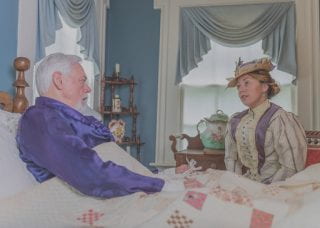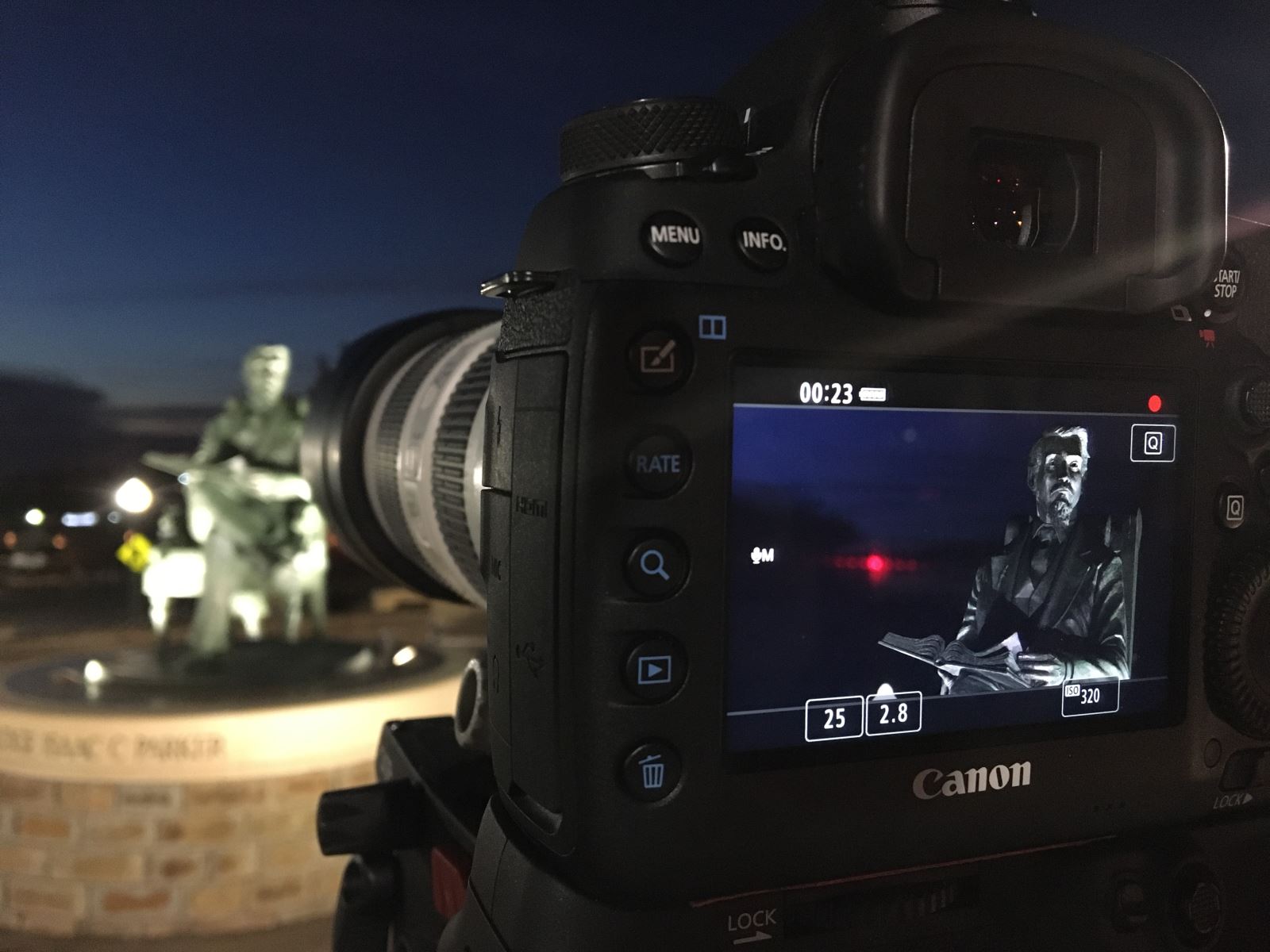New Film Explores ‘Indians, Outlaws, Marshals and the Hangin’ Judge,’ Premieres Next Month

Top: Bill Rogers as Judge Isaac Parker and Jennica Schwatzman as Ada Patterson re-enact an 1896 interview, filmed at the historic Headquarters House in Fayetteville. Middle: Larry Foley and Schwatzman discuss a scene. Bottom: The Judge Parker sculpture in Fort Smith.
While the new documentary film Indians, Outlaws, Marshals and the Hangin’ Judge is a story set in the late 19th Century, it covers numerous topics that still resonate today, including racial bias, gun violence, Indian affairs and accusations of police brutality.
Next month, on Thursday, Sept. 10, the U of A-produced film will premiere live from the Fort Smith Bakery District as well as stream live from the film’s Facebook page for that night only. It will also later be available for purchase through the University of Arkansas Press.
The film, from the producers of The Buffalo Flows and The First Boys of Spring, explores the myth, legend and reality behind federal judge Isaac C. Parker, known as the “hangin’ judge,” who for 21 years after the American Civil War hanged 79 men on gallows that were nicknamed the “government suspender” in Fort Smith, Arkansas.
 A sneak peek of the film gives a behind the scenes look at the “making of” and features two songs by National Park Radio, “Blood” and “Old Forests,” which were taped at the Buffalo National River for the documentary.
A sneak peek of the film gives a behind the scenes look at the “making of” and features two songs by National Park Radio, “Blood” and “Old Forests,” which were taped at the Buffalo National River for the documentary.
“It’s the colorful story of Indian removal, crime, capital punishment and an infamous federal judge who sentenced scores of felons to ‘hang by the neck until you are dead,'” said Larry Foley, the film’s director and producer, and chair of the School of Journalism and Strategic Media.
 Journalism alumnus TJ Holmes introduces the film, actor Jennica Schwartzman portrays Ada Patterson and M.F.A. theatre alumnus Bill Rogers portrays Judge Parker. Many interviews throughout the film also feature experts from the U of A, including Interim Provost Charles Robinson, law’s Stacy Leeds, communications’ Frank Scheide and history’s Elliott West.
Journalism alumnus TJ Holmes introduces the film, actor Jennica Schwartzman portrays Ada Patterson and M.F.A. theatre alumnus Bill Rogers portrays Judge Parker. Many interviews throughout the film also feature experts from the U of A, including Interim Provost Charles Robinson, law’s Stacy Leeds, communications’ Frank Scheide and history’s Elliott West.
Additionally, emeritus professor Dale Carpenter is the film’s editor, emeritus professor James Greeson composed the film’s original score, journalism’s Hayot Tuychiev is its director of photography, and history’s Patrick Williams served as one of the film’s humanities scholars.
“This is the story of how desperadoes — depending on your interpretation of history — were either tamed or tortured by a man some historians call a megalomaniac, while others choose to believe the judge was nothing more than a civil servant doing his job,” said Foley, adding that this included the judge himself, who once said, “People have said to me, ‘you are the judge who has hung so many men,’ and I always answer: ‘it is not I who has hung them. I never hung a man. It is the law.'”
Foley also said that Parker’s lawmen were said to have been as mean and deadly as the fugitives they captured and shackled in a dungeon known as “Hell on the Border,” in sight of the nooses that would often be their ultimate fate.
But the central figure of the film is Parker, the former U.S. congressman from Missouri, commissioned by President Ulysses S. Grant as the all-powerful judge over the Western District of Arkansas, with jurisdiction over Indian Territory.
“In those days, if Parker sentenced you to death, that was it,” Foley said. “There was no appeal process.”
Foley said that outlaw gangs hid from the law in lands given to Native people, until Indian Territory was taken away and turned back to settlers in 1896. Then, on Sept. 1, 1896, by act of Congress, the Federal Court at Fort Smith, Arkansas, was stripped of its jurisdiction into Indian Territory.
A 29-year-old St. Louis Republic newspaper reporter, Ada Patterson, was assigned to write about this event. She came to Fort Smith to interview Parker, who was in the last stages of Bright’s disease, which would soon take his life.
Parker told Patterson gripping tales of his court, his view of American Indians and his view on those who stood trial before his bench.
The film Indians, Outlaws, Marshals and the Hangin’ Judge is told in first person using the actual words written by reporter Patterson in September 1896, and the real-life story is set in and around Fort Smith around the same time and place as the fictional Western novel and film, True Grit.
Patterson narrates the film, much as Mattie Ross told the story in the Charles Portis classic. Patterson’s interview, and her colorful description of the gallows and jail, serve as the foundation for the film.
“With careful and honest detail to the words and visual history of the era, we re-create Patterson’s interview with Judge Isaac Parker, which was conducted on the day Parker’s court was stripped by Congress of its jurisdiction over Indian Territory,” Foley said, adding that when Parker died, the Fort Smith townspeople were so sick of his infamous notoriety that their mayor ordered the gallows outside the federal courthouse to be burned down.
“But over time, legends have grown into myth, and much of the truth has been spun into fable,” Foley said. “This film will tell real stories, shedding new light on what really happened in those turbulent days, while ‘busting’ myths of some of the farfetched tales that have appeared as fact in books and movies since the time of Parker’s passing.”
The film is a production of the U of A’s David and Barbara Pryor Center for Arkansas Oral and Visual History and the School of Journalism and Strategic Media.
For more information, visit judgeparkerfilm.com.
This story also appeared in the University of Arkansas News publication.

